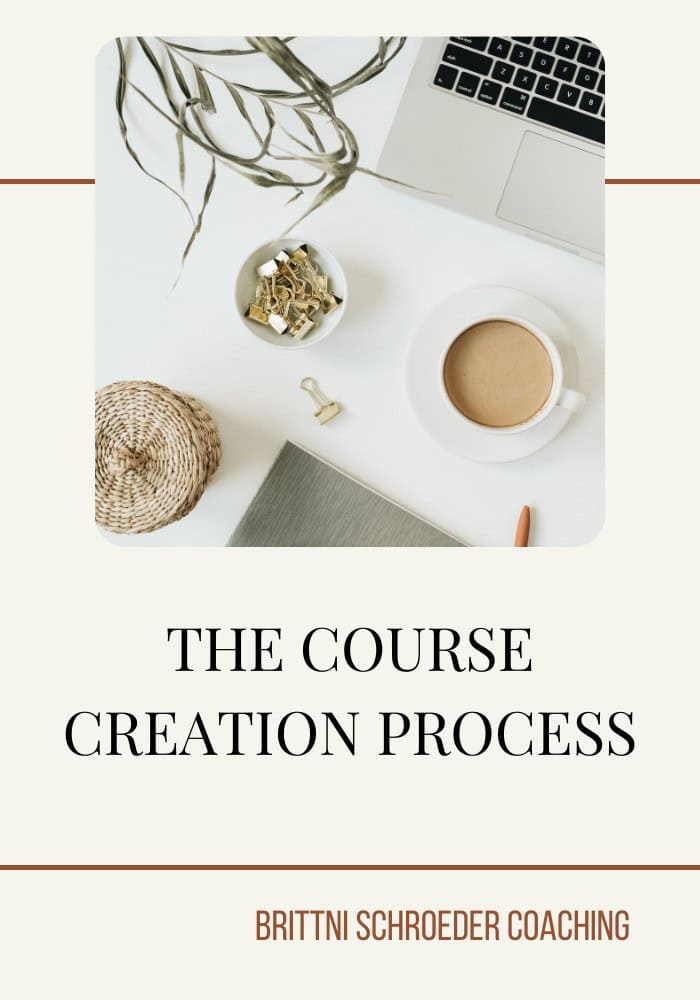brittni schroeder
BLOG
Brittni Schroeder Coaching
The Course Creation Process

You are only one person. Keep that in mind when you are creating your product suite. Consider products that allow you to create a passive income such as ebooks, templates, books, or digital courses. In order to build a production suite it’s important to understand the course creation process.
If you are service-based, creating a digital course is a great option to sale and grow your business. Once you have done your market research and tested your ideas on your target audience, it’s time to create.
Once you know who you’re helping and your topic, it’s time to explore the details or delivery.
Here are some questions to help you decide your content format:
- Which format do you enjoy?
- What different types of content have you done before? Think writing, webinars, videos, and audio.
- Highlight the ones that you enjoy doing the most and make you feel like you are in flow.
Keep your audience in mind as you create. For example, if you’re helping busy entrepreneurs, include audio as opposed to an ebook. This serves them better because they can listen to your audio while they’re going about their busy day.
Plan your content
Once you’ve got an idea of your content format, it’s time to plan out your content. You want to get clear on where your audience is before they find your course (POINT A) and where they are after they’ve done your course (POINT B).
Next, brain dump all the steps they’d need to take to move from Point A to Point B. Determine the main key points or topics and list all the subtopics for each.
For example, if I am creating a program on Instagram, one of my main topics might be Instagram Bio and my subtopics would be Profile Picture, Descriptions, and Call To Action. Your main topics can be your modules and your subtopics can be the lessons.
Now you have the framework and outline for the course creation process. It’s time to start creating content. Take each subtopic or lesson and write it out. I write each of my lessons and blog them. This also helps improve SEO. Don’t worry about putting all your content on your blog. Trust me, although all the content is available for free, people won’t take the time to search through all your blog posts. Your clients will prefer the ease of having all the content in one easy-to-access place. I also include the written content for clients to reference if they are visual learners and like to read.
CREATING VIDEO CONTENT
Now is time to start putting together the content. There are so many different ways to create video content. There is no right or wrong way. You have to find what works best for you.
There are a few different ways I deliver video content. The first option is to record yourself speaking using your iPhone or DSLR camera. The pro of this method is that your audience builds a connection because they see your face and emotion. The con (for me anyway) is it takes me twice as long when I am recording video because I get distracted with how everything looks. I know! I know! I am obnoxious!
The second option is to create detailed slides and record the slides with audio. I use templates from Canva and customize them to be cohesive with my brand. Once they are screen recorded I upload them to Adobe Premier Rush to make a few minor edits and add transitions to help it flow.
If you opt for the second option, I would recommend starting with an introduction video of yourself welcoming people to your program and then a video at the end congratulating them for completing the program.
EXTRAS
When writing out your program look for ways you can add extra support for your clients through the program. This can be in the form of a checklist, worksheet, planner, calendar, or template. These supporting resources add an extra element that clients love.
Creating a course takes commitment and time. There is a learning curve when it comes to course creation. Don’t get frustrated if you find yourself spending an entire day trying to figure out how to do one thing. The more you do it, the more proficient you will become at course creation. The course creation process takes time and effort, but the results are worth the effort.
